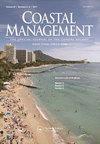Marine Finfish Aquaculture Planning Using MCDM and Numerical Modelling Tools to Aide Industry Expansion along the North Borneo West Coast
IF 1.9
4区 环境科学与生态学
Q4 ENVIRONMENTAL SCIENCES
引用次数: 0
Abstract
Abstract Site selection is the foundation of sustainable finfish culture, and in the tropics, there are vast offshore areas where this is needed. This study is the first to identify areas for marine finfish culture along the North Borneo West Coast using outputs from hydrodynamic modeling coupled with GIS and Multiple-Criteria Decision Making Analysis. Site selection criteria included: water depth, current speed, significant wave height, sensitive habitats, reported fishing grounds, government-based exclusion zones, oil & gas consents, and navigation routes. Of an initial 2.55 million ha, 1.05 million ha was eliminated from consideration based on physical characteristics alone. Of the 1.50 million ha identified to satisfy physical and hydrodynamic criteria for surface-oriented farms, a further 0.06 million ha was eliminated due to sensitive habitat and government exclusion zones. The remaining 1.44 million ha was found suitable for surface pen farming and 0.61 million ha for submerged pen farming. Much of this potential area is shared with capture fishery grounds, oil & gas consents, and navigation routes that will require further assessments (e.g. EIAs) to determine specific impacts to those industries. Those areas not in multi-user conflict makes up 0.57 million ha and 0.28 million ha for surface and submerged farms respectively. Highlights Coastal and offshore finfish culture is globally underdeveloped and lacking robust site selection MCDM with numerical modeling is a promising aquaculture site selection tool Our MCDM conducted in discrete phases; did not require criteria ranking Our approach helps to streamline site selection in areas with limited resources.利用MCDM和数值建模工具进行海洋鱼类养殖规划,以帮助北婆罗洲西海岸的产业扩张
摘要选址是可持续鳍鱼养殖的基础,在热带地区,有大量的近海地区需要这样做。这项研究首次利用流体动力学建模的输出,结合GIS和多准则决策分析,确定了北婆罗洲西海岸的海洋鳍鱼养殖区域。选址标准包括:水深、流速、有效波高、敏感栖息地、报告的渔场、政府禁区、石油和天然气许可以及航行路线。在最初的255万公顷中,仅根据物理特征就取消了105万公顷的考虑。在确定的150万公顷土地中,由于敏感的栖息地和政府禁区,另有6万公顷土地被淘汰,以满足地面农场的物理和水动力标准。其余144万公顷适合地表围栏养殖,61万公顷适合水下围栏养殖。这一潜在区域的大部分与捕捞渔场、石油和天然气许可证以及需要进一步评估(如EIA)以确定对这些行业的具体影响的航道共享。这些未处于多用户冲突中的地区分别占地表和水下农场的57万公顷和28万公顷。亮点沿海和近海鳍鱼养殖在全球范围内不发达,缺乏稳健的选址。具有数值建模的MCDM是一种很有前途的水产养殖选址工具。我们的MCDM分阶段进行;不需要标准排名我们的方法有助于在资源有限的地区简化选址。
本文章由计算机程序翻译,如有差异,请以英文原文为准。
求助全文
约1分钟内获得全文
求助全文
来源期刊

Coastal Management
环境科学-环境科学
CiteScore
6.00
自引率
0.00%
发文量
24
审稿时长
>36 weeks
期刊介绍:
Coastal Management is an international peer-reviewed, applied research journal dedicated to exploring the technical, applied ecological, legal, political, social, and policy issues relating to the use of coastal and ocean resources and environments on a global scale. The journal presents timely information on management tools and techniques as well as recent findings from research and analysis that bear directly on management and policy. Findings must be grounded in the current peer reviewed literature and relevant studies. Articles must contain a clear and relevant management component. Preference is given to studies of interest to an international readership, but case studies are accepted if conclusions are derived from acceptable evaluative methods, reference to comparable cases, and related to peer reviewed studies.
 求助内容:
求助内容: 应助结果提醒方式:
应助结果提醒方式:


